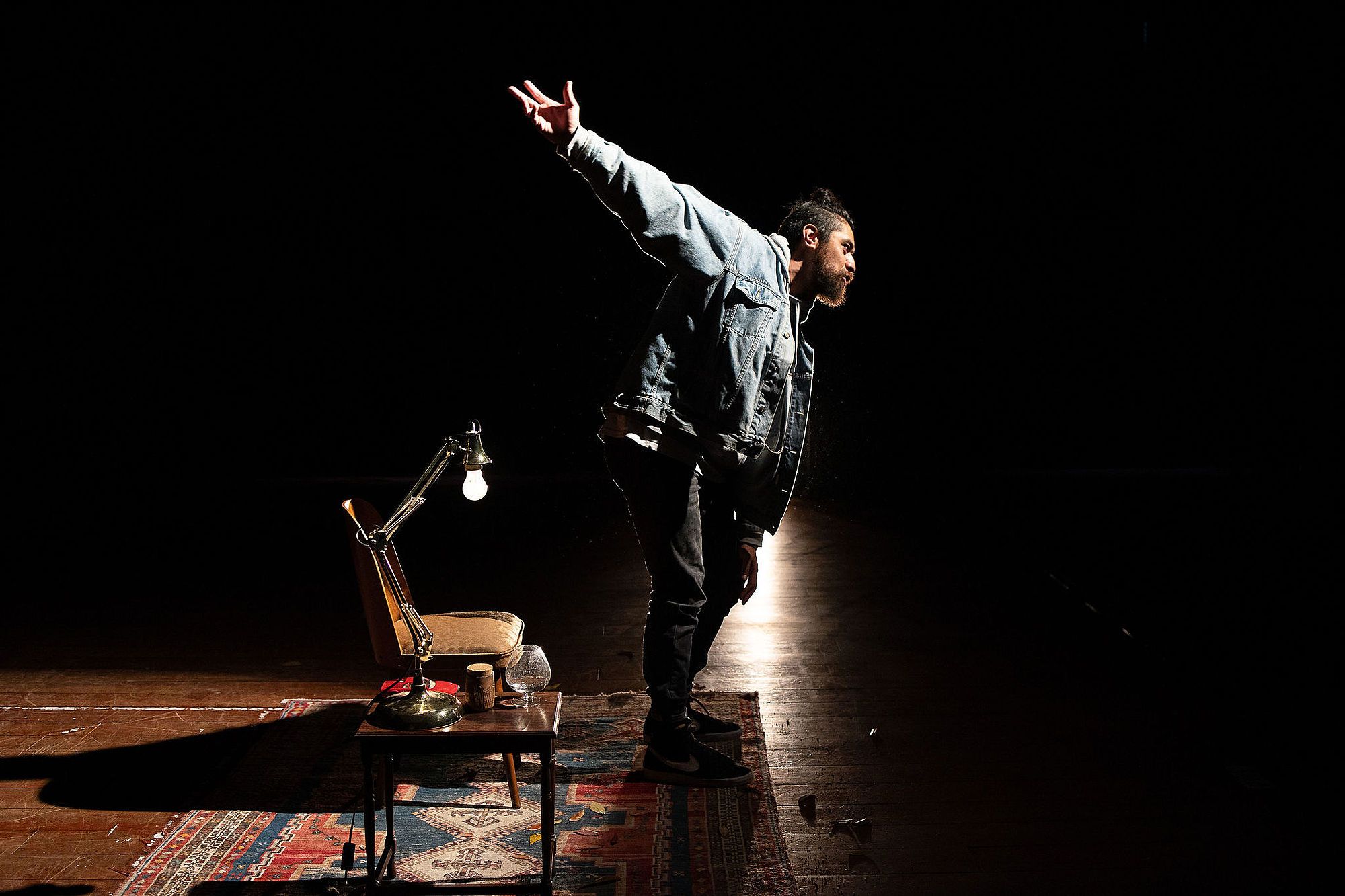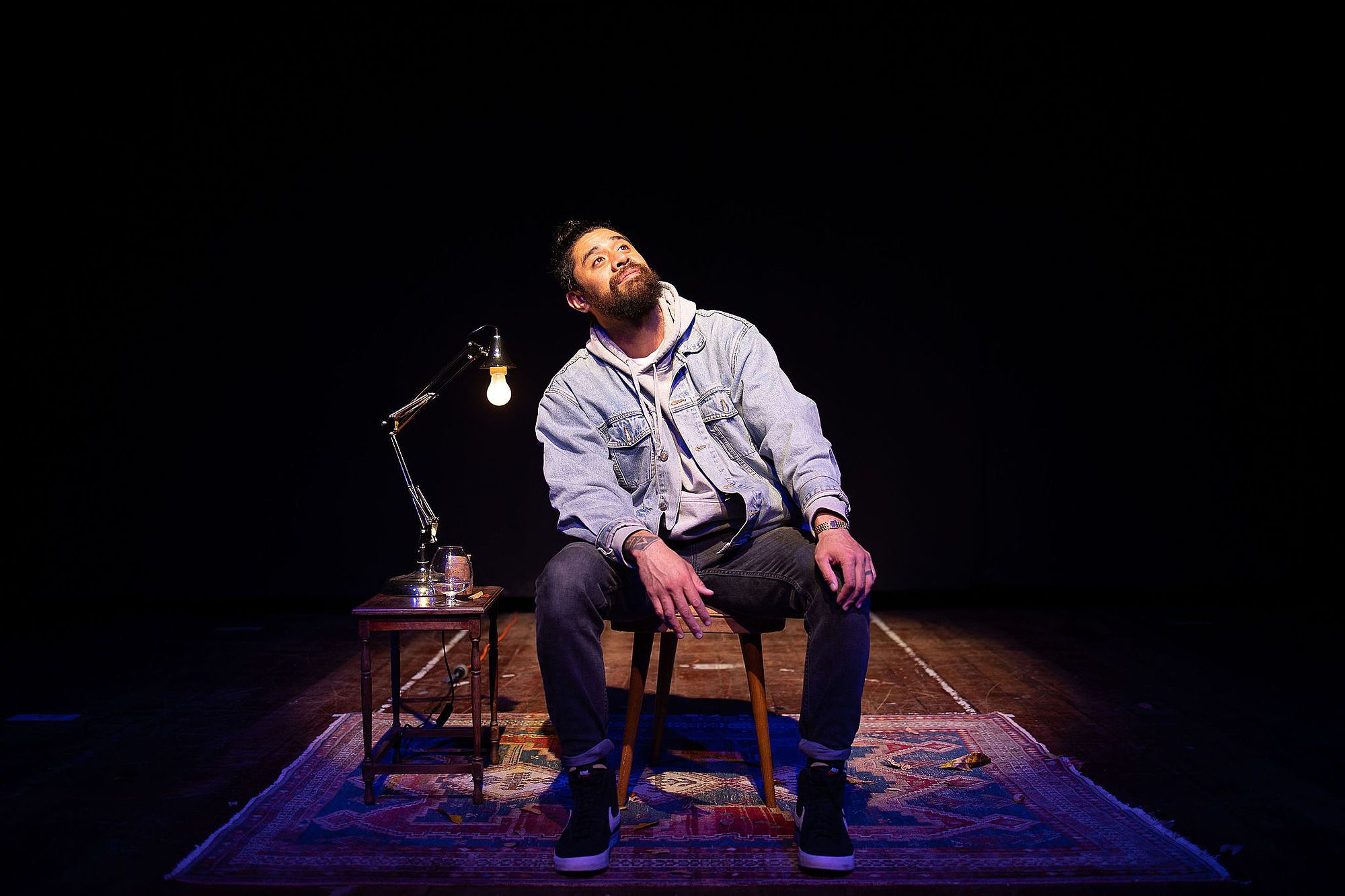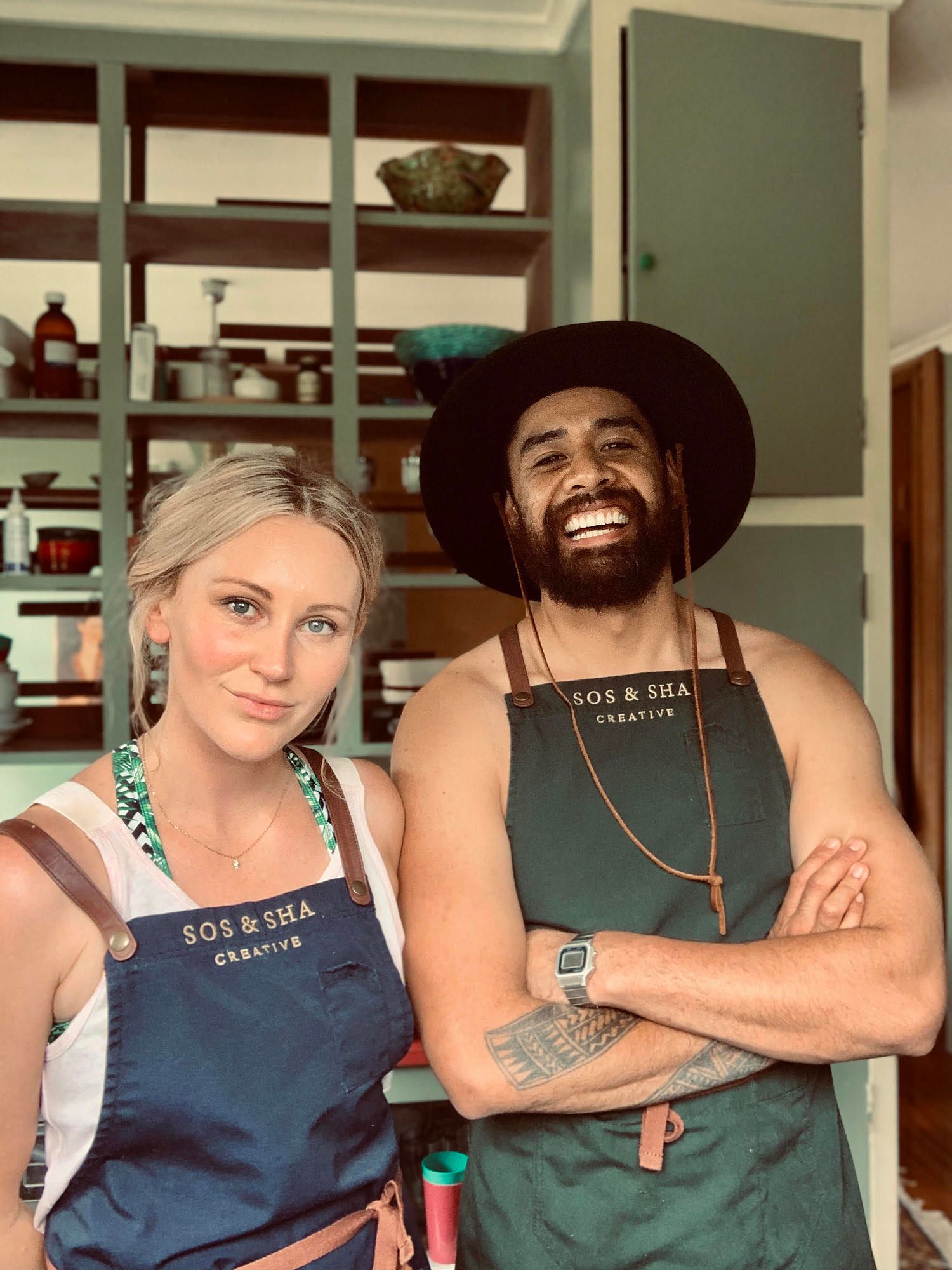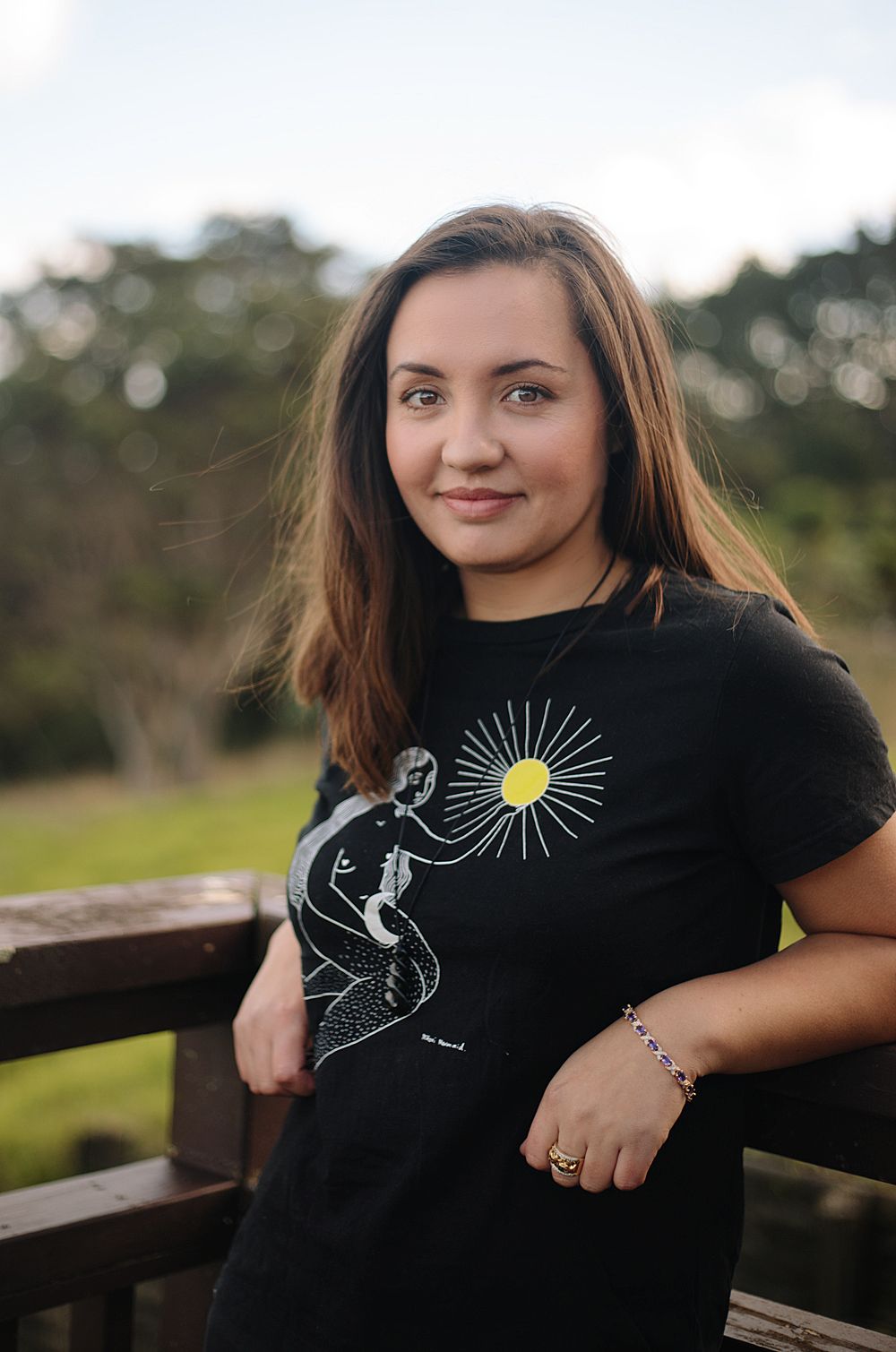The Brown Kid Who Can Do Anything
Ataria Sharman reviews Waiting, a play by Shadon Meredith and directed by Amelia Reid-Meredith, and chats to the theatre makers about vulnerability, whakapapa, and being parents.
I see an old frayed rug with a wooden chair, a table with a glass of water and a lamp, in the centre of the auditorium. The lights dim and now it’s dark and we, the audience, have gone quiet. There’s a hum in the air and then the lights come back up, and Shadon Meredith is now sitting in the chair, hair tied into a topknot. He’s wearing casual clothes and what I think are Nike kicks, but I can’t be sure, and he looks cool, effortlessly cool, confident. Immediately, there’s this sense of something in the air. I can’t put my finger on what it is and then I realise it’s warmth. There’s a warmth to this performer, to this performance, and it’s not just the orange tinge emitting from the lamp. He begins speaking. “You, my little boy, are the life-giving sun.”
This play is his memoir, in the form of a letter to his son. I was lucky enough to speak to Shadon and the director of Waiting, his wife Amelia Reid-Meredith, before the show. “I am giving this story over to him [his son],” says Shadon. “Sometimes in life we are going to hit walls, we are going to hit bumps. I want him to know that sometimes we have to know how to sit in adversity, how to stay in the darkness but then hopefully figure out when to keep moving.” There is an overhanging vulnerability, spoken completely through poetry. It’s a narration of Shadon's life here in Aotearoa as a Sāmoan New Zealander, the challenges he's faced and the wins, too. It’s a love letter, and that in itself has a sense of vulnerability, particularly for a man. “It’s hard to be vulnerable, but during the show, there are these moments of vulnerability… through the poetry I hope that is what I am sharing.” It must take strength to stand on that stage alone and share from the deep recesses of human experience. “We’ve had really good feedback from dads who came to the show because they don’t often get written or talked about, and we have this massive problem with male suicide and male depression,” says Amelia.
It’s a love letter, and that in itself has a sense of vulnerability
There is an interweaving of whakapapa here, an acknowledgement of his Sāmoan ancestry as Shadon’s hands start the motion of traditional dance. Shadon’s nana migrated to Aotearoa in the 50s, before the Dawn Raids, and he remembers talking to her about them. “She struggled with [the Dawn Raids] as someone who already lived here. It was hard for her to witness the persecution of Pacific families who had more recently moved when, as a Sāmoan person, she had already been a part of Aotearoa for so long.” Shadon’s nana was well educated and came from a wealthy family in Sāmoa. Her upbringing gave her a sense of confidence and helped her deal with the racism she encountered from Pālagi. Amelia, who is Pākehā, recalls the mana she felt from Shadon’s nana. “When I would go to her house and see her and the other elders, I could feel the mana she and the other women had,” she says, “I was always in awe of them.”
There’s an intense intention in the use of props in this performance. In one of the first scenes, Shadon holds a handful of pieces of paper at his head height and blows them, and they float down to the wooden floor like confetti. I feel as though the pieces are the letter to Shadon’s son. But I’m not sure. Were those pieces of a letter or were they something else? Later on, Shadon scatters leaves, setting them free from his hands. They drift down to the stage as a reference to autumn, the changing of seasons, of life. The lighting is red and he says, “I walk forwards, backwards.” Later, he sprinkles snow from between his fingertips. Letter, leaves, snow. Letter, leaves, snow. Summer, autumn, winter.
this show isn’t linear, and the time-travelling feels magical
In another scene he’s calling out to his mum, “mummy, mum, mum”, and we realise through the way he calls her name that he’s time-travelling from childhood into teenagehood. As the audience laughs along with the attitude of teenage-Shadon, I realise that this show isn’t linear, and the time-travelling feels magical. Shadon says, “I’ve spent a bit of time working for Red Leap Theatre, and they use a lot of magic in their shows. I love that kind of magical nostalgic feeling. So I used some of the skills I learnt from them and moulded the transitions into seasons, which helped with timing.”
Shadon Meredith. Photo credit: Sarah Marshall Photography
As a young boy growing up in Pōneke, Shadon’s nana taught him to speak Sāmoan. Immersed in the dominant Pākehā culture, however, he began having identity issues and felt embarrassed to speak it:
My mum and her siblings grew up in a time of active language suppression and at some point in my life, I realised I could no longer speak my language. It was frustrating to have known how and then suddenly not be able to. At school, I wanted to be like the real brown boys, and then, like, there was the other side with all these white boys taking me on. High school was really difficult. I would hang with the Lebanese boys and then I realised that I was finding myself through a culture that was not my own.
Shadon’s rap-like recitation of the words and timing is on point. He’s practised and professional and the words pop. With the line “Can we call you dad you’re cool” he elicits laughs from the crowd and then we know how much he was looking for a father figure, making this letter to his son so poignant. Shadon actually began rapping back in college:
I like the rhythm of it. Even just having a conversation, having those words at your disposal, it’s powerful. Sometimes I ask myself what kind of story I want to tell. I was good at English but never passed. So I did rapping instead. When I was at high school, we used to listen to 50 Cent and Ginuwine. We would get down and hang back and do clown rapping, battle rapping, funny dude – but I remember being kind of frustrated because the other raps weren’t that good. Then I went to Toi Whakaari and became a ‘serious’ artist. I started to write poetry, but it was secret. I didn’t even want to put it online, I thought it was self-indulgent. It felt private to me.
When Shadon handed Amelia a mix-tape of his poems, Waiting started to come to life:
I’d written a lot of poetry and so I kind of gave like 15 to Amelia and presented it like a music tracklist, like a poetry mix-tape. I love the idea of that, the poems as [an album], holding a body of work. It felt like I could be free with what I was writing about.
I ask Amelia and Shadon what it was like to work together on Waiting.“She really inspires me, my wife,” says Shadon. “We’ve worked together since drama school and it does come quite naturally for us. Though we sort of made a pact for ourselves that we can talk in the car about work, until we get to a certain point, and then we need to stop, or we are taking it home.”
Amelia continues:
So he handed his poems to me and I was secretly like, what am I going to do with this? Shadon wanted me to do the show with him, but he didn’t even know what it was. So I gave him some provocations, and from that, the show began to unfold into what was kind of Shadon’s life story, and the form that emerged was a letter to our son Arlo. When we discovered that, it kind of made sense of it all. Gave it structure.
Amelia Reid-Meredith and Shadon
Shadon puts the hood of his grey jersey over his head to signify another time change. He’s a young adult now and he’s angry and he’s pissed. He’s stuck in the hurricane and we see a youth still figuring out how to deal with the world around him, as he “fills up a storage system with hate.” A red toy car and flashes of red and blue lighting signify the siren of a police car and there’s a car crash, or at least I think there is. It’s clear that life hasn’t always been easy on Shadon, there’ve been challenges and low points. Flashing red lights and pain and grief and a sense of unknowingness. A sense of waiting. For Shadon, part of the meaning behind Waiting is to “encourage [Arlo] to move through his stuff ... that what he is thinking is really valid, but he just needs to keep moving through it. Be young, be dumb, that’s what is going to happen. Life is shit sometimes but you keep moving.” I’m glad Shadon did continue moving, otherwise we wouldn’t be here now, the audience watching Waiting unfold.
Shadon’s nana is central in this play, she’s mentioned multiple times, a rock, a solid foothold in the complex unravelling of his life. She was alive when Shadon and Amelia first put on Waiting in 2017 at Nelson Fringe Festival. But then two and a half years ago she passed away.
There is a palpable sense of grief in a later scene about Amelia’s mum, as Shadon refers to the toutouwai, the robin, and then he lifts up and kisses the toutouwai, “sending her home.” This season of grief for Shadon and Amelia was a significant reason for the rewriting of Waiting. “The grief we went through with Nana's death and the death of my mother changed us and now as we looked at the script, we realised how much [it] needed to change, which is why we are in the process of reworking it,” says Amelia. “Through Waiting we hope other people will connect with their own experiences of grief. There’s that collective idea of waiting, the unknown and the fear and the grief of losing a loved one, and the moment you realise you’ve lost life as you know it."
superheroes don’t die and is that what we love about superheroes so much, that they don’t have our fragility?
In that scene, Shadon is in Te Waipounamu. With one hand he’s reaching up, up, and although I don’t know what he is reaching for, it is clear that he does. Amelia is from Te Waipounamu, “I grew up on a farm in Nelson, which is also featured in the story. Shadon and I moved down there to look after my mum, who had terminal cancer. Waiting was born out of the time we spent down there. Although we live in Auckland we spend a lot of time there – to me, it still feels like home.”
Amelia’s mum was the dramaturg for Waiting, while on her deathbed. “We weren’t sure if we were still going to do the show, because of her illness, but my mum was like, ‘No you’ve got to do it.’ I didn’t want to go to the Nelson Fringe Festival awards because Mum was in the hospital and I wanted to stay with her, but she was adamant we had to go. She even gave me her credit card and told me that if we won anything, to buy ourselves a bottle of bubbles. And then we did. We took out the awards.”
There’s love here, a love for his son, a love for Amelia, her mother and his nana. Soul deep revelations. He says, “Uso like the new spiderman [spider web shooting sounds]”, and we are reminded that superheroes don’t die, but human beings do and is that what we love about superheroes so much, that they don’t have our fragility? Further on he says, “I will not sit idle while my creative kinfolk take their lives.”
Amelia and Shadon
There’s a scene where a spotlight shines on Shadon, projecting his silhouette up onto a curtained wall. The shadow version of him looks 10 feet tall and it’s like there are two of them – is that his shadow-self or is that his reflection?
After graduating from Toi Whakaari, a challenge for Shadon was learning how to operate in the world of acting, influenced as it is by the dominant Pākehā culture. “As I started to attend auditions, it became clear that I wasn’t brown enough for the brown roles, and too white for the white roles.” Amelia tells us, “Shadon was the top student in our class at Toi Whakaari.” Shadon continues, “I had done all this work and it was kind of shocking to come out and not have a job – the job I thought that I was going to get. This is the reality for most drama school graduates. But I’ve moved past that, I’ve been in the industry for 11 years now.”
Shadon, or is it 10-foot-shadow Shadon, challenges the moon for the death of his loved ones. We feel his anger in the loss of those who now live on that “potted earth”. The lighting again changes, and Shadon’s shadow is now behind him, a long black shape on the floor. Shadon is talking to his son and reminding him that his ancestors, “all live within you my son”. His hands move again into the movements of traditional Sāmoan dance and he sits back down on the chair. The crowd laughs when he says, “God is good if God were here”, and he reminds the audience that “we are only human, Arlo”.
For Shadon, the idea that one day you might have to ‘kill your sensei’ holds meaning:
The world is changing so fast and I think opening up this space for Arlo hopefully reminds him that we don’t know everything so, as his parents, one day he might have to turn on us … one day, we might have to follow him instead of the other way round. I hope for that. I think, as parents, you want your kids to be better than you.
This show feels like a selection of moments in time, punctuated more importantly by the spaces in between, the waiting. In Waiting, Shadon wants to give the audience a moment “to reflect on their own lives, and see how amazing their life is. Even if it is hard, we get to see ourselves in a beautiful way and how it makes you who you are. I think Waiting offers moments for people to be reflective and feel vulnerable.”
Waiting ends with Shadon speaking the single word “breathe”, and then the lights dim and I feel like I really do need to take a breath, to feel and experience everything that I’ve just seen. I feel a sense of bewilderment that I’ve been on a journey, a journey spanning Shadon’s life.
The performance is polished, from the use of lighting to communicate context and the range of colours to convey emotion, to the bare but symbolic setting. This demonstrates the care with which Amelia Reid-Meredith has directed Waiting. Shadon, in my opinion, is an undeniable acting talent. Taika Waititi – if you are reading this, Shadon needs a big film role!
Shadon is also passionate about supporting Brown artists. “I do theatre and acting to boost Oceania and to boost Brown people and remind us that we are not separated – we are all together.” There’s a lack of diversity to this year's Whangārei Fringe Festival (I can’t comment on other years as this is my first), and so as a Māori woman, I’m grateful to Shadon and Amelia for bringing Waiting to us.
Shadon tells me, “When I perform, I perform for that one Brown kid who might be in the audience. Who might not have thought about it, or realised they could be an actor. I perform so that they could know, they can do anything in this world.” I get the sense that Shadon was once one of these Brown kids and so will be his son Arlo. Although I don’t see any kids in this particular audience with its 8pm start, there are some grown-up Brown kids, my partner and I, and I’m grateful for the reminder, from Brown kid to Brown kid, that we can do anything in this world, and to see a grown-up Brown kid with his Pākehā wife, doing just that.
10–26 October




